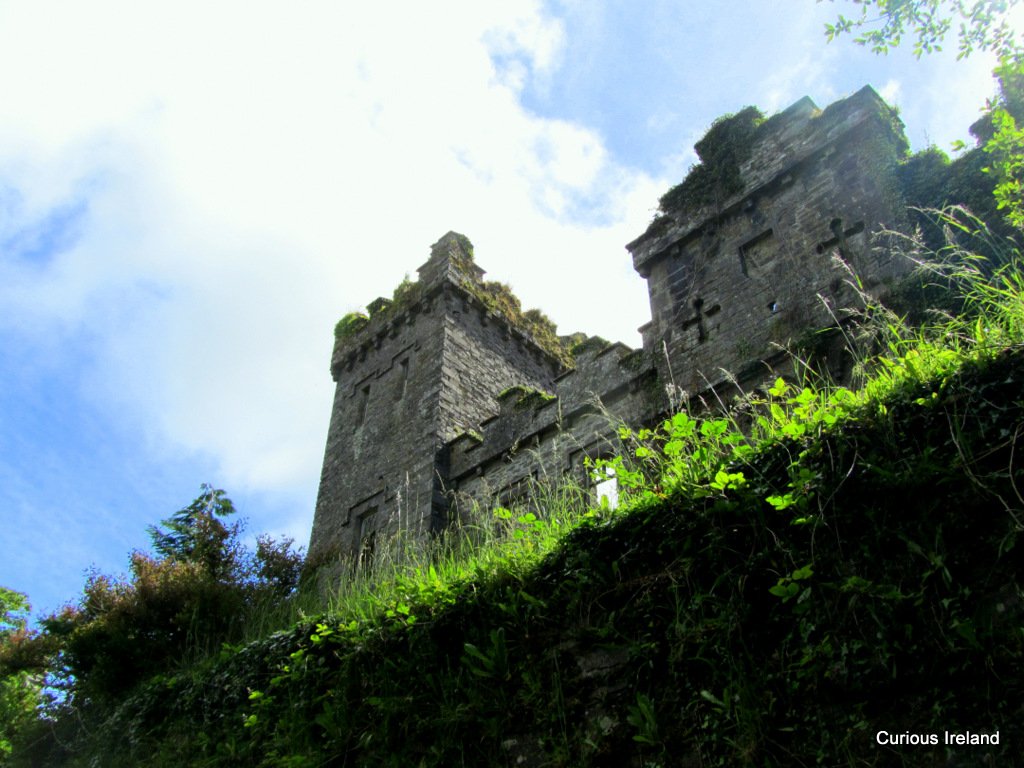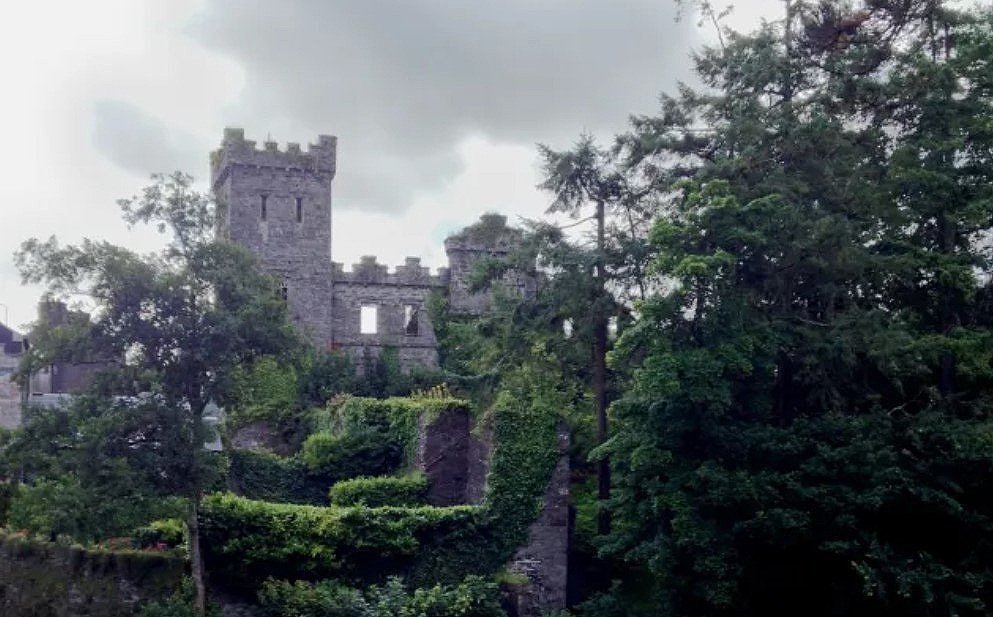
History and Folklore
Macroom - A Social History
Macroom, like hundreds of other towns, began as a primitive settlement on the banks of a river, In this case the Sullane. The area was reasonably sheltered and more fertile than the surrounding hills. In the 6th century it was known as Achad Dorbchon within the kingdom of Muskerry.
The area is rich in archaeological artefacts such as gallauns, stone circles, dolmens, cist graves, ring forts, fulacht fiadhs and souterrains. It is reported that the area was an important centre of pre-Christian and post-Christian worship. Very slowly over the centuries the power of the druids waned and Christianity took over. Evidence suggests that the ruins of Macloneigh church is the site of St. Finbarr’s first church. Other saints associated with the area include St. Gobnait, St. Lachtain, St. John and St. Berrihert. Alliances and rivalries between tribes flourished during those early centuries. A major battle took place at Bealach Leachta (Bealick) in 978 AD. Brian Boru avenged the death of his brother, Mahon, and became king of Munster by defeating Maolmuaid and a large force of Danes. From Cashel he built up his power. At Clontarf, in 1014, he defeated the Leinstermen and the Danes but was killed himself with his eldest son, Murcadh. His other sons, Tadgh and Donnchad lost power to Mael Seachnaill who became high king until 1022.The O’Flynn family became one of the most influential families in the region. They are credited with building the Castle in Macroom in the 12th century. Subsequent development centered around the Castle and it became the capital of Muskerry. The McCarthy’s defeated the O’Flynns and occupied the Castle until the middle of the 17th century. They controlled thousands of acres in Muskerry, Duhallow and Carbery. They built castles at Carrigaphoca, Carrigadrohid and Blarney (1446) Cormac McCarthy founded Kilcrea abbey in 1456 and was buried there after being killed by his brother in1494.
At the end of the Elizabethan wars the castle was successfully besieged by Sir Charles Wilmot. Many of the occupants were killed trying to escape and an alleged £5000 worth of furnishings were lost in the blaze. The 16th and 17th centuries were turbulent times in Ireland as Henry V111 and his daughters, Mary and Elizabeth tries to “plant” the country and bring it under English control. In 1650 Cromwell’s general, Lord Broghill, took the castle, killing up to 700 troops. Bishop McEgan was captured and when he refused to plead with the garrison in Carrigadrohid to surrender he was hanged with the reins of his horse. Later, General Ireton sent forces from Kilkenny which burned the Castle and most of the town Cromwell gave the Castle and 3,000 acres to his friend Admiral Sir William Penn. Penn’s son, also named William, lived for a few years in Macroom. He went on to lead a very interesting and adventurous life. He became an avowed Quaker and founded the state of Pennsylvania.
The McCarthy’s, who had always survived through diplomatic marriages and being loyal to the crown, regained the Castle again but finally lost it in 1691. The Castle was sold to Hollow Blade Co., London which sold it on to Francis Bernard, son of the Earl of Bandon, in 1702. He sold it to the Hedges Eyre family which married into the White family of Bantry. When William White, the 4th Earl of Bantry, died the Castle passed to his sister Olivia who married Edward Arthur Guinness and became Lady Ardilaun. British auxiliaries occupied the Castle in 1920-1921. During the Civil Was, the anti-treaty forces burned the Castle in August 1922 before retreating westwards. In 1952, local trustees bought the Castle Demense from Lady Ardilaun for £1500. for the people of the town. Sports fields, a golf club and Bishop McEgan College were later developed on the site. The ruins of the Castle were considered unsafe in 1967 and the main structure was demolished.
Macroom progressed slowly from a ragged settlement of mud cabins in the middle ages to a more structured and organised environment. By 1800 the town was circled by seven estates ranging from Brown’s of Rockborough (454 acres) to Mount Massey (13,363 acres). Landlordism is usually and understandably portrayed in a very negative light but progressive landlords did much to improve areas that would otherwise lie neglected. They developed land, roads and buildings; they modernized farming; they provided employment for crafts people, carpenters, masons, tailors, shoemakers, coopers, tanners, nailers and blacksmiths. The unskilled and the landless who drifted in from the countryside were poor and were most vulnerable when the Famine struck during the 1840’s. A workhouse opened in 1843 at a cost of £6,800. It was built for 600 people but held an overcrowded 2,124 in 1851. If, as evidence suggest, 1,000,000 died of hunger and disease between 1845 and 1851, it means that 456 souls perished every day for six years. By about 1900 another million had emigrated.
Then social and economic divide changed after the Famine. Surprisingly, perhaps, the Protestant population declined. They migrated, emigrated and married outsiders. Many Catholics who survived the Famine moved into town and through education, hard work and luck found work or became established in business. Gradually reconstruction and renewal took place. The first train arrived in Macroom on May 12th 1866. About 80,000 travelled to and from Cork in the first six months. Goods, especially cattle, could be transported quickly and easily.
In the early years of the 20th century the old, established order was disintegrating across Europe and Macroom was no exception. The Land War and the decline of landlordism, WW1 and 1916, The War of Independence and the Civil War contributed to this. Macroom continued to be significant market town but traditional trades and crafts declined. The town failed to attract much industry until the 1960’s when factories such as The Carpet Factory, Wessman Toys (1971), Tape Factory (1971), Cake Decorations (1970), and Paper Sacks (1975) were established. The loss of these factories and, in recent years, G.I. and Neville’s Bakery means a renewed effort must be made to create employment. Let’s hope the large extension to the Danone plant in Castle View is the start of that.
Historic Places around Macroom
Situated on the N22 midway between Cork City and Killarney is Macroom, a busy market town in the valley of the Sullane River.The town has a colourful history and a range of activities for the visitor, making this an ideal destination for a relaxing vacation in County Cork. Go fishing in the local river or go golfing at Macroom Golf Club and other surrounding clubs. You can also enjoy hill walking or cycling, as the area has various trails and pathways.
The Gateway and tower are all that remain of Macroom Castle, which was granted to Admiral William Penn, (father of the founder of Pennsylvania U.S.A.) by Cromwell.
Macroom is twinned with the Breton town of Bubry. and Marcallo con Casone in Italy.
At a place called Bealick, near Macroom, there is a stone formation called a Dolmen. Within its confines were buried the bones of the dead after cremation. Such monuments were erected c.4,500 years ago. There are many such stone alignments and circular mounds, liosanna, within which families lived up to 1,000 years ago. People congregated at strategic positions for religious and social purposes. One such meeting place was at a ford on the River Sullane, at the Sloping Plain - Magh Chromtha - Macroom. Here was a druidic centre, where Crom, among other deities, was worshipped.
A major battle took place near Macroom in the year 987 A.D. Brian Boru's brother, Mahon, had been killed by Maolmuaidh of Cineal Aodha and Imhar, a Danish chieftain from Limerick, at Laharan in Aghina parish. A year later Brian Boru engaged Maolmuaidh and the O’Mahonys, whose allies included the Danes and the O’Donovans , in the Battle of Bealach Leachta, at the confluence of the Sullane and the Laney. The battle lasted all day and there were hundreds of casualties. Maolmuaidh was slain and Brian Boru was eventually declared King of Munster. This was the first major battle between the Irish and the Danes (Vikings), which came to a grand finale at the Battle of Clontarf in 1014 with victory for the Irish.
The name Macroom can be explained in 3 ways:
1) Derived from the Irish version of Maigh Chromtha or crooked plain 2) Said to have its origins as the Plain of Crom the pagan God 3) Based on the name for a tree near the bridging point of the river, translating as "crooked Oak".
First documented reference to Macroom reaches back to about 550 A.D., when it was known as Achad Dorbchon and existed within the Kingdom of Muscraighe (Muskerry). Up until 1600, this area is referred to as a major religious centre. It was an ancient burial ground; the Bards of Munster congregated here; it also served as the seat of the Bishop of Cork.
The earliest evidence of settlement at Macroom is in the form of archaeological ruins, some of which are still visible today. These include ring forts, stone forts, fulacht fiadhs (cooking pits) and souterrains (underground passageways). Standing stones are noticeable in the district. They dot the landscape with great regularity. Some of these mark prehistoric burial sites. Some of the stones are as high as 15 feet with some of the stones bearing Ogham inscriptions. The area represents the home place of St. Finbarr, founder of Cork City, and the site of his first church near Macloneigh.
During the reign of the Ui Fhloinn (O'Flynns) tribe in the 12th century a castle was built at Achad Dorbchon (Macroom). Evidence suggests that the O'Flynn family were one of the earliest and most influential families of the Muskerry region. They had their headquarters at Macroom and established the first village site. The castle was the focal point for all subsequent development at Macroom.
In the 13th century Macroom suffered 3 invasions. The final one was by the McCarthys who went on to become the dominant and most powerful family within the region up to the end of the 17th century. The rise in prominence of Macroom was due to the early influence of the O'Flynns and the McCarthys.
Macroom Castle, the boyhood home of William Penn, stands on the western margin of the town of Macroom and its windows look away into the distance, where a rugged land lies at the foot of the mountains. Part of the castle is said to have been built in the reign of King John. It was granted to Admiral Penn instead of the property of his wife Margaret near Rineanna and later returned to the Earl of Clancarty; the Admiral received instead an estate in Shanagarry in East Cork.

